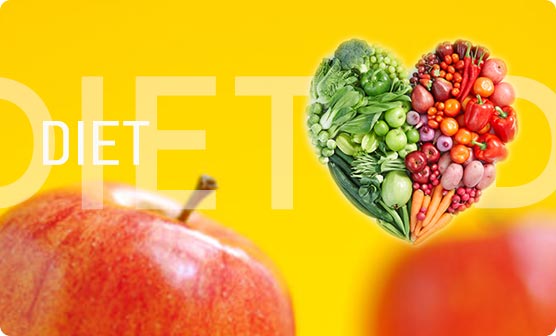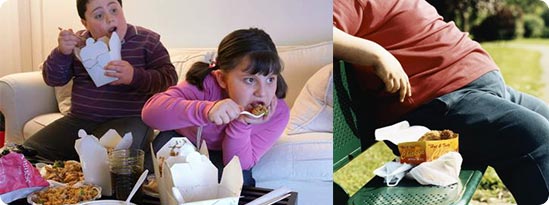Diet control

Food is the prime factor that promotes the welfare of our health.
The energy that we have to go about our daily activities is derived from the food we eat. When the food we eat is more or when it is too less, it can result in diseases. It is imperative for us to have a harmonious blend when it comes to our bodies, food, and sports and other physical activities.
These are the times when our food habits have been challenged: the fast food scenario has led to unhealthy food choices; playing a big role in turning us into sick patients. These bad habits are to be discarded and we should adopt a healthy diet and appropriate eating pattern.
Bad eating habits lead us onto lots of diseases. There are several reasons why this happens. People move about very less nowadays. Yet the amount they eat has not become less. Moreover the food we eat is not balanced.
Control of food intake is vital for diabetic care. What is commonly seen is that people have a casual attitude: a “let it be”, “we eat what we need; let it be” we’ll face it when it happens.
They even dismiss others who try to eat healthy. This is mainly because such people do not have no knowledge about food or the nutrients in it, nor do they have any idea of what a person can eat.
Remember it is important that we know
WHAT to eat
HOW to eat
HOW MUCH to eat
Diabetes and dietary pattern
The dietary pattern of the diabetics should be same as that of other members of the family .there is no need to separately cook their foods. Dietary pattern of the diabetic patient should be healthy and well balanced and that is suitable for other members also.
The meal pattern of the diabetic patient should be such that it controls diabetes and other lifestyle diseases
How important is a balanced diet?
Healthy Eating
If you follow a healthy eating pattern it is possible to prevent lifestyle diseases.
To have a healthy diet we need to give importance to 6 factors:
The time when you eat
The way you eat
The amount you eat
The way you cook
Is your diet nutritious?
Balanced diet
The time at which you eat
We should try to eat at the same time every day. When we do not follow this routine it affects our health adversely. Try to set aside a fixed time every day taking into consideration your daily routine and other household requirements and duties. Do stick to that routine. Do not skip breakfast. It is common even among children to neglect their breakfast. This has a chance of negatively affecting their studies and even their concentration!
The way we eat
When we eat we need to follow
Eat you food slowly
Chew your food properly
Drink 8 to 12 glasses water daily
The quantity we eat
It is possible to determine the amount of food we need when we consider our age, height, weight, type of work, and if we are regular in sports and any physical activity. We should eat according to that. The food that we love and find hard to give up should be consumed in small quantities.
If there is any food we love so much that we find it hard to give up, we should try to eat very small quantities of it
The way we cook
There are lots of changes in the way we cook when compared to earlier time. If we do not adopt the proper way to cook, there is not much use even if we choose the right food ingredients. The wrong cooking method will lead to the loss of nutrients in the food
Be sure of the following while cooking:
Include lots of vegetables
Steaming and boiling are good methods as they enhance the nutrition
Limit to the bare minimum, the use of frying and deep-frying
Avoid reusing oil when frying
It is not good to reheat food which has been refrigerated
Limit the use of coconuts and oil while cooking
Do not consume pickles and pappads every day
Is your diet nutritious?
When we choose our food it is important to think of whether it will give us proper nutrition. Often we fall sick due to the lack of proper nutrition that protects the body against illness.
Balanced diet
A balanced diet is a diet where there is a proper balance in the choice and use of food grains, meat, fat, vegetables, fibre, and water. A balanced and sound diet will help in maintaining our health and preventing diseases
If you suffer from diabetes you should never fast. It is not good for a diabetic to avoid eating, or to skip a meal
Calorie
This is a term that we often hear when we talk about food. What is a calorie?
A calorie is the measure of energy that the body gets from food. When one gram of food is digested the energy that is released is what we call calorie.
How much a person eats a day depends on how much of calories he requires. The amount of calories the individual needs depends on factors like age, weight, height, level of activity and exercise, and status of health. A diet catering to these factors is advised.
It is good if you approach your doctor or a dietician for a suitable diet to be prescribed. A total turnaround in your diet pattern is not what is suggested; rather a diet which considers existing eating habits and preferences; and designed in a manner where a few alterations can bring about healthy changes. What we need is a diet which gives us enough nutrients .
Food Pyramid
This is a food pyramid. What you need less of appears on the top. The essential food is on the lowest rung of the pyramid. As you go lower down the pyramid you spot the food which gives you the best in terms of nutrients
Oil. Fat, Sugar, Salt – Eat very less
Fish, Meat, Eggs, and Milk – Eat a little
Vegetables and Fruits – Eat more
Rice, Wheat, Grains - Eat more of
Calorie Count
Food –cooked and snacks
| Food | Quantity | Calorie |
| Chappathi | 25gm of wheat, 1no. | 80 |
| Idli | 25gm of dough, 1no. | 80 |
| Rice(cooked) | 25gm of rice,½ cup | 86 |
| Brown bread | 25gm,I slice | 60 |
| Noodles | 100gm(1 pkt) | 435 |
| Samosa | 1no. | 260 |
| Burger | 1no | 330 |
| Potato chips | 100gm | 570 |
| Barfi | 1 piece | 100 |
| Halwa | 1 piece | 570 |
| Gulabjamun | 1 piece | 100 |
| Jilebi | 1 piece | 200 |
| Mysore Pak | 1 piece | 357 |
| Rasagulla | 1 piece | 150 |
| Laddu | 40gm | 250 |
| Jam | 1 tbsp | 100 |
| Horlicks | 2 tbsp | 41 |
| Bournvita | 3 tbsp | 38 |
| Tea with no sugar | 1 cup | 22 |
| Coffee with no sugar | 1 cup | 25 |
Nutrition through Food
Nutritious food is necessary for the well-being of the body; for it to perform well and for energy and health. We should take food that has all the needed nutrients in the right amount.
Grains/ rice; Fat; Meat; Vitamins; Vegetables/minerals
Grains-Carbohydrates
The function of carbohydrates is to produce energy. 60% of the energy we use should come from carbohydrates.
From 1 gram of carbohydrate we get 4 calories of energy
Fat/Lipids
25% of the energy required for the body is from fat. There are two types of fat: Saturated Fat and Unsaturated Fat. Too much of saturated fat will lead to increase in cholesterol
From 1 gram of fat we get 9 calories
Meats-(Protein)
15% of the energy is got from meat/protein
From 1 gram of meat we get 4 calories
Vitamins
Vitamins are needed for the body to function well. Vitamins are required in only small quantities.
Minerals
Like vitamins, minerals also help towards the upkeep and health of the body
Grains
While having these remember not to remove the bran. Boiling rice repeatedly in water and throwing the water away is not good. Among rice, parboiled rice and wholegrain wheat (where the bran is not removed) are good. However wheat with all the bran removed and polished; i.e. maida, is of no value at all
Beans
All the different types of beans are good. When we eat we tend to remove the outer skin of lentils (kadala); this is not advisable as the skin contains lots of vitamins. When we sprout beans to eat them it enhances the protein content. Try to include a bean–food at least in one of your meals daily
Fish, Meat, Eggs
Do include fish in your daily diet. Fish contains omega fatty acid which helps to protect the heart. The following types of fish may be included in your diet: Sardines(Mathi), Mackerel( Ayala), Tuna(Choora)
Meat can be had once or twice a week. Have mutton in limited quantity as the saturated fat content is not good for the heart. The level of cholesterol in the yellow of eggs is high. Boiled eggs are good for growing children; on alternate days it is good to give them eggs. Egg whites can be had daily. Adults should limit their consumption of eggs to once or twice a week. Frying and deep frying any of these is not recommended at all
Vegetables, greens, fruits
These provide the body with essential substances: Fibre, vitamins, minerals,. All these constitute to make vegetables a necessary part of your daily life. These are times when we do not see much of these vegetables around. Yet do try to include greens in your diet for at least three days a week. Fruits should be included in daily diet.
Milk, milk products
These have lots of proteins in them; and should be included in a growing child’s diet. However, adults need these dairy products only in limited quantities
Sugar, Fat
These are to be avoided as far as possible; and consumed in very limited amounts, for all age groups. Keralites are prone to lifestyle diseases; and such food should be taken in restricted quantities. This habit needs to be introduced from childhood
Fibres
Dietary fibre refers to the food that the body does not digest
There are two major types, depending on their ability to dissolve in water.
Soluble Fibre
Pectin, Gums, Beta Glucans, Mucilages, Hemicellulose
Insoluble Fibre
Cellulose, Lignin
Advantages of Fibre
It helps to regulate the glucose in blood. It serves to regulate the cholesterol content in blood. And helps the smooth flow of food to the digestive tracks.
The fibre that does not dissolve in blood helps to ease constipation; and the fibre that dissolves in blood protects against heart diseases, diabetes, obesity and unhealthy cholesterol levels.
Food with high fibre
Grains with bran
Beans and other bean varieties with their skin
Vegetables
Greens/ leafy vegetables
Fruits

Diabetics remember when you are eating :
Avoid sugar
Oil and coconut in moderation
Eat at the same time every day
Try to avoid fried and deep-fried food
Fruits – include one or two in your diet daily
Include vegetables, greens in all your meals
Meat – chicken, with the skin removed. Try to avoid mutton
Avoid as far as possible: Parottas, Bakery snacks, Soft drinks, Yellow of egg
Limit intake of salt
Include grains with the bran
Limit milk to not more than 250mg a day
Control the amount of food that you take
Drink 8 to 12 glasses of water daily
Do not take too many cups of coffee or tea
Foods to be avoided: Sugar, Honey, Glucose, Jaggery, Alcohol and alcoholic beverages, Soft Drinks, Horlicks, Boost, Bournvita, Mangoes, Jackfruits, Sapota, Dried Fruits
Glycaemic Index – GI
Glycaemic Index is an indicator of the rise in the level of glucose in blood after taking in a measured quantity of food. Food is ranked according to this. On consuming food with a high glycaemic content the level of glucose in blood rises. Diabetics should consume food with low glycaemic content.
| High GI | 60 and above |
| Medium GI | 40 – 59 |
| Low GI | 20 – 39 |
| Very low GI | 19 and below |
GI levels of some food:
| Rice | 58 |
| Wheat | 48 |
| Potatoes | 74 |
| Beans | 30 |
| Apple | 37 |
| Bananas | 53 |
| Peanuts | 33 |
Model Plate
Many of us are a bit unsure when we talk about dieting ( e.g 1 cup/katori, 2 ladles, 2 spoons ). To clear this confusion a Model Plate helps. The model plate is a simple tool to guide us in deciding what we should choose and how much we should consume.
With regard to a diabetic this model plate is ideal:
A quarter of your plate should be filled with grains – eg : rice/ chappathi/ dosa etc.
Protein should make up the other quarter – eg : fish/ beans/ chicken. Once a week chicken, and on those days do not take fish
The other quarter should have cooked vegetables
The remaining quarter to be filled with salads – cucumber, carrot, tomato, onion
A small cup/katori of curd, or a glass of buttermilk
And gravy – eg,rasam, morukari, pulishheri etc.
1500 Calorie Diet
08.30 am Breakfast : Any one of the below
| Idli | 3 (sambar, tomato chutney) |
| Dosa | 2 (sambar, chutney) |
| Upma | 1 ½ cup |
| Appam | 2 (peas curry) |
| Oats | 3 tbsp |
| Chappathi | 2 (Mixed vegetable curry) |
11.30 am Any one of the below
Tea / Buttermilk / Lemon juice
01.00 pm Lunch
| Rice | 1 and ½ cup |
| Vegetable thoran | 1 cup |
| Fish | 2 pieces / ½ cup pulses |
| Curd | 1 glass and Cucumber salad |
04.00 pm Tea
Biscuit – 2 / Robesta – 1 / Guava -1
08.00 pm Supper
| Chappathi – small | 3 |
| Vegetable thoran | 1 cup |
| Salad or Rice | 1 cup |
| Pulses | ½ cup |
| Buttermilk | 1 glass, Cucumber salad |
Zimbabwe Hand Jive
Our palms are a good means to know how much we should eat. They help us to realise the measure we can adopt; besides being the one trustworthy tool we always have with us to have an idea of the right quantity to consume. This hand measure has been called the Zimbabwe Hand Jive as it is based on a measure used in Zimbabwe.
Rice
Two measures of a closed fist
Protein
As much as your palm can hold
Vegetables
as much as two palms can hold
Oil and Fat
A Thumb measure
Yoga

Mental stress in these days is increasing for all human beings. This affects our lives in a bad manner and increases our chances to contrive all sorts of diseases. Our biggest wealth is good health. We need to have a way of living that enhances our ability to love, be happy and live a healthy and satisfying life. Yoga helps us achieve this.
Yoga helps us with these practices:
Yogasanas, Pranayama, Yoganidra, Meditation
Health is the biggest wealth. Mental stress affects diabetics in a bad way. Try to avoid confrontations of any kind, and be calm and happy. Yoga helps to calm our minds to a great extent. Yoga and meditation help to calm our minds. Yoga nidra soothes our muscles and calms our thoughts. All this adds to the body harmony
The practice of yoga is beneficial to children: it calms them, removes laziness, tackles loss of memory, removes restlessness, and improves their self-confidence
Benefits
Regulates our hormones
Improves the nervous system
Makes the body flexible
Moderates the blood flow in the body
Strengthens lungs
Improves the nervous system; which helps relieve mental stress.
Mental Stress
We are living in the age of globalisation. This has brought in its wake increasing consumerism and competitive trends which in turn has resulted in changes in social behaviour: in our relationships with each other. Earlier we would have an easy approach towards day-to-day problems. Nowadays we adopt a more intensive ‘fight or flight’ approach. A do or die attitude is what we have when confronted with problems. Either fight or flee! Such an approach does harm to our bodies.
There are two different nerve systems in our bodies
Sympathetic
para-sympathetic
Sympathetic system
These sense are aroused when we are confronted with a harmful situation. The body releases some hormones; which will increase our heartbeat, breathing, level of sugar in blood. This will then lead to a rush of oxygen, sugar, glucose to all parts of the body and renders the body into a tense state. Prepare to fight or flee, it prepares the body into a state anticipating a battle. The level of cholesterol increases and the arteries become narrow. All these harm the body. Yet when in an emergency this is the right response; this is necessary.
Para-sympathetic system
After the crisis and when the body has overcome the danger, it returns to the normal state. The para-sympathetic nerves gets active. This action is in the opposite manner. It reduces heartbeat, breathing goes down, the sugar in the blood goes down. It acts in such a way as to reduce the wounds which came about when the sympathetic nerves were aroused and hormones were released. Gradually the body returns to its earlier state.
Repetitive stress injury
The challenges that people have to face in these modern times are not life-threatening. The pressures we face are related to work issues, problems that crop up on a personal and social level; conflicts of a modern lifestyle and the real world are some of the challenges we face.
However our body does not know that; and it reacts in the manner which it is familiar with. When in a confrontation it goes into an aroused state. In the modern world people go through this state of confrontation and crisis almost all the time. There is hardly any time to relax. And so the body is always in this state of active arousal. This leads to wounding the body in several ways. This is what is known as repetitive stress injury.

Diseases that happen due to mental stress:
Due to the continuous performance of the sympathetic system the blood sugar rises. Diabetes is the likely result. Heartbeat will rise, and so will the blood pressure. These will then in turn affect the kidneys
Techno Stress
Constant interaction with computers and other modern technological inventions leads to tension. This is what is known as ‘Techno Stress’. Hours of constant sitting and working and work pressures to top that will affect us in a negative way. Each individual will get affected in a different manner.
Exercise

Remember to choose an exercise that you enjoy doing and find easy to be regular with.
Those who suffer from any disease should refrain from heavy exercise, and bearing weights; be sure to choose an exercise programme with the advice of your doctor
Benefits
Maintains energy
Increases endurance
Increases flexibility
Reduces overweight
Helps to maintain weight
Controls depressive tendencies
Encourages a healthy attitude and mental state of mind
Improves sleep
Controls blood pressure
Helps control of blood glucose
Strengthens heart
Regulates cholesterol
Improves blood flow in small blood vessels
Reduces the chances of heart attacks
Walking is an ideal exercise for diabetics. Do seek the advice of your doctor before starting to walk. Keep aside 30 minutes every day for your walk
A life with no exercise: the problems
Increases chance of diseases
One of the reasons for getting diseases like diabetes, heart diseases, and cancer is the lack of exercise
Paves way for lack of enthusiasm, laziness, body weakness
Increases mental stress
Calories Spent in the following:
| Work 30 minutes | Calories spent |
| Walking ( 4 km in an hour) | 80 |
| Brisk walking | 160 |
| Bicycling (15km in an hour) | 180 |
| Running (6 km in an hour) | 175 |
| Swimming | 215 |
| Gardening | 150 |
| Wiping floors | 105 |
| Dancing | 185 |
| Jogging | 300 |
| Football | 334 |

Try to adopt a way of living which increases your physical activity
Walk instead of taking a vehicle for short distances
Use staircases instead of lifts
Take part in the daily housework
Avoid sitting for long in front of the television. Get up and walk a bit in between shows
Avoid the habit of getting others to do things for you. Get up and get active
Do the gardening at home by yourself
On off days and holidays do take part in some sports
When is exercise not to be done?
When the body temperature is above 101 degrees
When you have some disease
When there is pain in the body
When the blood pressure is high
When the glucose content in the blood is very high
